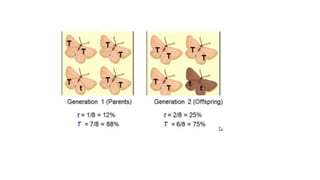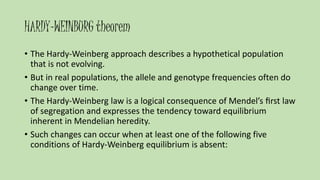What is evolution
- 1. PRESENTATION TITLE FACTORS INITIATING MICROEVOLUTIONARY CHANGES BY CHANGING GENE FREQUENCIES SUBJECT: EVOLUTION AND PRINCIPLES OF SYSTEMATIC ZOOLOGY PRESENTED BY AFTAB BADSHAH
- 2. Outline Evolution Microevolution Gene pool Gene frequency Hardy Weinburg theorem Factors initiating microevolutionary changes
- 3. What is evolution Evolution, also known as descent with modification, is the change in heritable phenotype traits of biological populations over successive generations. Scientifically evolution can be defined as “a change in the gene pool of a population from generation to generation by processes like mutation, natural selection, and genetic drift.”
- 4. microevolution Microevolution is evolution on a small scale — within a single population. That means narrowing our focus to one branch of the tree of life.
- 6. What is gene pool • Collection of all alleles of all genes possessed by members of a population. • Constitution of all copies of every type of allele at every locus in all members of the population.
- 7. Gene frequency • Proportion of a particular allele (variant of a gene) among all allele copies being considered. • Percentage of all alleles at a given locus in a population gene pool represented by a particular allele • The number of copies of a particular allele divided by the number of copies of all alleles at the genetic place (locus) in a population.
- 9. How Can We Check If A Population Is Evolving The hereditary process alone does not produce evolutionary change. In large bi-parental populations, allelic frequencies and genotypic ratios attain an equilibrium in one generation and remain constant thereafter unless disturbed by recurring mutations, natural selection, migration, nonrandom mating, or genetic drift (random sorting). Such disturbances are the sources of micro-evolutionary change.
- 10. HARDY-WEINBURG theorem • The Hardy-Weinberg approach describes a hypothetical population that is not evolving. • But in real populations, the allele and genotype frequencies often do change over time. • The Hardy-Weinberg law is a logical consequence of Mendel’s first law of segregation and expresses the tendency toward equilibrium inherent in Mendelian heredity. • Such changes can occur when at least one of the following five conditions of Hardy-Weinberg equilibrium is absent:
- 11. 1. No mutations. The gene pool is modified if mutations alter alleles or if entire genes are deleted or duplicated. 2. Random mating. If individuals tend to mate within a subset of the population, such as their near neighbors or close relatives (inbreeding), random mixing of gametes does not occur, and genotype frequencies change. 3. No natural selection. Differences in the survival and reproductive success of individuals carrying different genotypes can alter allele frequencies. 4. Extremely large population size. The smaller the population, the more likely it is that allele frequencies will fluctuate by chance from one generation to the next (a process called genetic drift). 5. No gene flow. By moving alleles into or out of populations, gene flow can alter allele frequencies.
- 12. Factors Initiating Evolutionary Changes Any population which fails in Hardy-Weinberg equilibrium undergoes evolutionary changes. These evolutionary changes are brought about by the following agencies which tend to alter the gene frequencies of the population
- 13. 1. Mutation. • Mutations are changes in the structure of genes and chromosomes. • Origin of all new genes and a source of variation that may prove adaptive for an animal. • The Hardy-Weinberg theorem assumes that no mutations occur or that mutational equilibrium exists. • Mutational equilibrium exists when a mutation from the wild-type allele to a mutant form is balanced by mutation from the mutant back to the wild type.
- 14. 2. Gene Flow • Gene flow = migration either immigration or emigration • The Hardy-Weinberg theorem assumes that no individuals enter a population from the outside (immigrate) and that no individuals leave a population (emigrate). • Migration alters the gene frequency of the population by introducing new alleles or escorts the population alleles to elsewhere.
- 15. 3. Natural Selection • Natural selection= survival of the fittest • Natural selection can change both allelic frequencies and genotypic frequencies in a population. • Natural selection acts on the whole animal, not on isolated traits. • An organism that possesses a superior combination of traits will be favored. • Occurrence of natural selection in a population upsets the H-W theorem
- 16. 4. Random Mating • If mating is nonrandom, genotypic frequencies will deviate from Hardy-Weinberg expectations. • Individuals of the population mate independently not with the same genotypes changes gene frequency • Random mating upsets H-W theorem as the gene frequency changes.
- 17. 5. Genetic drift • The changes in allele frequencies in a population due to random fluctuations is simply termed as genetic drift. • Genetic drift can lead to the loss or fixation of deleterious, neutral, or beneficial alleles. • Certain circumstances can result in genetic drift having a significant impact on a population. • Two examples are the founder effect and the bottleneck effect.
- 18. The Founder Effect When a few individuals become isolated from a larger population, this smaller group may establish a new population whose gene pool differs from the source population; this is called the founder effect. The Bottleneck Effect A sudden change in the environment, such as a fire or flood, may drastically reduce the size of a population. A severe drop in population size can cause the bottleneck effect, so named because the population has passed through a “bottleneck” that reduces its size
- 22. FURTHER READING. 1. Cell biology, molecular biology, genetics, evolution and ecology by P.S Verma and V.K Agarwal ; multicolor edition; chapter 7; population genetics and evolution page 888----901. 2. Campbell biology 10th edition by Reece, Urry, Cain, Wasserman, Minorsky and Jackson; unit 4; mechanisms of evolution; chapter 23 “the evolution of populations”; page 484----542. 3. Integrated principles of zoology 14th edition by Hickman, Roberts, Keen, Larson, I’Anson, Eisenhour; part 2, continuity and evolution of life; chapter 6, organic evolution; page 126---130. 4. Miller-Harley Zoology 5th edition; part 1, Biological principles; chapter 5, evolution and gene frequencies; page 64---69. 5. Concepts of genetics by Robert J. Brooker, part VI, chapter 25; population genetics; page 614---640 6. Principles of genetics 6th edition by Snustad and Simmons; chapter 23; population genetics page 634---638.
- 23. THE END























